
home about us contact us subscribe

home about us contact us subscribe
|
|
|
|
INSIGHT: Critical Ingredients in Urban Placemaking
Successful public spaces, whether new, revitalized, or reclaimed, rely on a number of elements. by Randall H. Shortridge, AIA, RTKL/Los Angeles March 11, 2002 As a student, I stayed in
a small hotel for several days one summer alongside the Campo dei Fiori in
Rome. It was a typical European plaza of an earlier century: five- and
six-story masonry buildings gathered closely around a rough stone-paved plaza.
A diminutive fountain topped with a deeply patinaed bronze statue of local
importance commanded a place near its center. While four narrow streets
connected it to the rest of the city, standing in the middle of the plaza it
was impossible to see very far down any of them. The whole place was the size
of football field, no great churches or palazzos graced its perimeter, and not
a tree was to be seen. Yet this otherwise unremarkable space was filled with a
rich urban life. And I was enthralled. This “everyday” plaza
began each day as a public market replete with what seemed to be a hundred
stalls. By 10 in the morning the plaza evolved into a parking lot for the
vehicles of local workers; in late afternoon it became a soccer field for
neighborhood kids; toward evening a center of gravity for local retailers and
an outdoor seating area for surrounding restaurants. Finally, it ended each
night as a gathering place for tourists and students who loitered on the
fountain steps. And each day the remarkable cycle of uses began anew. Since then, I’ve wanted to
know what made urban places like this one so compelling to visit, to linger
within, and visit again? What activities are repeated? What physical
characteristics occur in successful gathering places regardless of their
context? What management characteristics invisibly support the quality of
space? In the introduction to “The
Death and Life of Great American Cities,” Jane Jacobs' seminal 1961 urban
planning criticism, she noted: "For illustrations [of her analysis] please
look closely at real cities. While you are looking, you might as well also
listen, linger, and think about what you see." In my spare time, I have
spent the last few years engaged in finding photographic illustrations, not of
the myriad urban ills that existed in Jacobs' time, but of ingredients of many
successful public places that exist today partly in reaction to the work of
Jacobs and her contemporaries. I believe the successful orchestration of these
ingredients in public spaces at all scales enhances the emotional well being of
users and the community as a whole. Shining examples like New York City's Bryant
Park (that was redesigned not too many years ago) are proving this assertion. The Ingredients From observing how people
use public space such as Bryant Park, Pioneer Square in Portland, Oregon, and
other compelling places during the past several years, I discovered that 40
critical ingredients are present in successful urban spaces. While it may not be possible for all public
spaces to include every ingredient, it’s readily apparent that a large
percentage of these must be included for a place to be comfortable, popular,
respected, and well used. These ingredients can be grouped into the following
categories: Character—compelling
physical characteristics establish a sense of place. Ownership—an
identifiable group has a sense of pride and responsibility for a definable
space. Authenticity—a
place exhibits genuine ethos of historic or contemporary meaning or context for
its users. Accommodations—amenities are present that provide for basic human needs and desires. Nature—water,
trees and plants, and sky and sun are present, attended to, and respected. Social and Private Space—talk, play, and special events as well as retreat
and solitude are accommodated and encouraged.
Several of these
categories and their associated ingredients are illustrated here with
photographs that I’ve taken, along with my observations. The photographs were
collected primarily while studying three cities chosen as great examples of
large, medium, and small urban ecosystems: New York City, Portland, Oregon, and
Savannah, Georgia. CHARACTER Urban spaces need clear
boundaries or limits and include attributes that make them unique and give them
focus. Spaces need to be enclosed, provide a sense of arrival, have scale
appropriate to the environment, and have character enhanced with stairways,
vantage points, and repeating patterns — all while being flexible enough to
allow a variety of functions to occur within. Gateways: add to the emotional sense of arrival when entering
a city, a district, a building, a plaza, or park. Enclosures: buildings,
landforms, landscape, and water bodies define space and create understandable
and psychologically defensible boundaries. Stairways: beyond providing access, a secondary,
yet possibly more important roll in the public realm: they provide seating and
a vantage point to survey the surrounding environment. Vantage Points: Simply said, we like to see what we can see. Patterns: in paving, in the landscape,
in building forms create soothing visual frames. Scale: precedent is the
best way to determine the correctly scaled space for a given activity. Flexibility: keep the middle open;
multi-use areas without fixed features near their middle allow them to function
like outdoor hotel ballrooms. (The Florentines knew this and kept statues like
Michelangelo’s David, regardless of its importance, off to the side.) OWNERSHIP Every urban space must
belong to a neighborhood, district, civic group, or other care taking entity
that is proud of, and responsible for, that place. Those individuals or
entities that assume ownership must allow democratic accessibility, ensure
safety and security, and provide for the maintenance of quality, durable, and
cost effective components within a defined boundary. In most cases, a resident
population comprises the soul of ownership. AUTHENTICITY Every urban setting has
unique features that make it like no other place. Historic artifacts,
information and educational markers, landmarks, and artwork express the unique
characteristics exclusive to that place alone. Authentic places derive
character and meaning from local history, local materials, local climate, and
local culture. Authentic urban spaces never deceive the user about where they
are. Artifacts: memorials and historic markers lend particular
significance to a place. Information and
Education: readily available
facts, from the history of neighboring buildings to the whereabouts of
restrooms or the types of trees overhead and plants underfoot, ensure that
places are easy to use and filled with learning. Landmarks: straightforward
or complex (but visually memorable) icons may have locally significant meaning
or can simply be fun or expressive, and often serve as meeting places or
directional indicators within the urban framework. Art: whether steeped
in social commentary or as expression of beauty, approachable public art lends
solemnity, joy, wonder, or debate to any space ACCOMMODATIONS Public urban spaces help
us relax, and in order to do so they should acknowledge our physical comfort.
Successful public spaces provide seating, restrooms, drinking fountains and
shelter, accommodate our pets and, where appropriate, encourage vendors to sell
food and various sundries. Seating: users can
rest, converse, and observe the world; movable chairs or benches are best as
they allow people to assemble seating groups as needed. Shelter: a place to
take refuge from the heat of the sun or a sudden deluge. Food and Sundries Vendors:
when available, we can and do stay longer; public spaces are enlivened
and enriched by the likes of restaurants with outdoor seating, news and flower
stands, and umbrella vendors who materialize when it rains. Pets: as friends and companions, they deserve a place to run,
socialize, get a drink of water and use the toilet, just as we do. NATURE Especially when enveloped
by the urban context, nature has profound psychological and therapeutic
benefits and should have some part in every urban place. Colorful planting, the
sight and sound of water, leaves moving in the breeze, the textures of stones
and plants, the smell of earth and flowers or the air after a summer rain, and
the sound and sight of birds and squirrels and other urban wildlife stimulate
our senses and make us feel better. When combined with the presence of the sun
and sky, the change of seasons, and the passage of time itself, we tend to
forget the pressures of life — we relax and are restored. SOCIAL AND PRIVATE SPACE Public space is the theater
of everyday life. There is joy and comfort in watching and socially interacting
with neighbors and strangers. Having places to sit and talk, run and play,
listen to music, watch jugglers, buy vegetables — and teach children to do the
same — is both a right and a responsibility. Also at the center of the public
environment, in the least likely of places really, exists the chance to be and
spend time alone. Dialogue: places
to meet and talk, to sit or stand in the sun and the rain, physically comfortable
and without the urgency of major thoroughfares. Play: broad expanses
of hardy turf or paved plazas allow organized or spontaneous play; for
children, playgrounds with imaginative features help them develop their
physical and social capabilities. Special
and regular events and performances:
markets and gatherings of all kinds, from celebrations to political
rallies, help define community — public places should always be equipped to
handle large groups of people. Quiet places: the most successful public spaces can allow truly private
moments; places where no one knows us and in which no one can disturb our
quietude. WHAT NEXT? Understanding the basic
ingredients that in some measure must be part of every successful urban space
should be the first step taken when trying to understand why certain places
are, or are not, “alive.” These ingredients can also be used when creating new
spaces or when evaluating existing environments for enhancement. As mentioned earlier, not
every urban space can have all of the critical ingredients noted, but a
majority should and can be present for a place to be successful — certainly at
least two or three from each of the six major categories. However, some
ingredients are always required — Management, Maintenance, Seating, and Sight
and Sound of Water to name a few. Some ingredients may not fit in a given space
— Steps or Vantage Point, for example. Further, other factors can be fatal
flaws. An artfully designed space with every one of the ingredients present or
accommodated will never be successful downwind from a landfill or removed from
the passage of pedestrians or nearby residents. Please visit urban public
spaces and look for these ingredients. Obtain a copy of the book “A
Guide to Great American Public Spaces” by Gianna Longo if you need help
identifying successful environments near where you live and work. Then start
observing: Can you identify ingredients that are present or missing in places
that you visit regularly? Are there missing elements that jeopardize the
success of a place? Are there other critical elements you can identify that I
have overlooked? I would love to hear about them. As for me, I will continue to
refine and incorporate these critical ingredients into my work. About
the author: Randy
Shortridge, AIA, is an architect and urban designer in the Los Angeles office
of RTKL. He recently completed design work on Mockingbird Station, an award
winning, transit-oriented mixed-use development in Dallas where many of these
principles were utilized. He can be reached at rshortridge@rtkl.com |
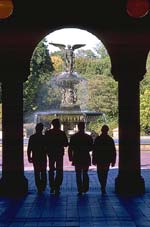 (Photo: Randall Shortridge) Gateways: A pedestrian tunnel under 72nd Street at the end of the Mall in Central Park provides a dramatic gateway to the Bethesda Terrace and Fountain; gateways add to the emotional sense of "arrival."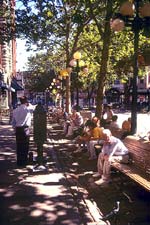 (Photo: Randall Shortridge) Seating and texture: Shaded seating is a valuable commodity on a warm day in Seattle; the tree canopy and varied paving add texture to the environment.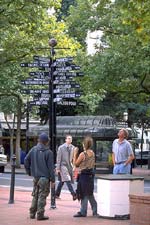 (Photo: Randall Shortridge) Information and education: Signs pointing to locales both near and far attract the attention of passersby at Pioneer Courthouse Square in downtown Portland, Oregon; markers should be easy to understand. (Photo: Randall Shortridge) Flexibility: The center of Pioneer Courthouse Square in Portland Oregon is left open to allow for a variety of activities. A citywide grass-roots campaign worked for 15 years and raised $1.6 million to turn the entire block into a flexible, well used, and much appreciated public plaza. (Photo: Randall Shortridge) Boundaries: As seen from the roof garden atop the Metropolitan Museum, a distinct street wall creates a powerful edge all around Central Park in New York City; little doubt exists about where the city ends and the park begins. (Photo: Randall Shortridge) Scale: A couple enjoys a quiet moment along an intimately scaled stream bank in Brooklyn's Prospect Park.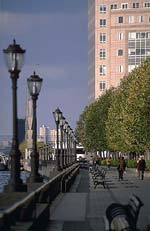 (Photo: Randall Shortridge) Patterns: Trees, benches, and lampposts create strong rhythms along the pedestrian promenade in Battery Park City, Manhattan.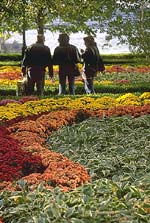 (Photo: Randall Shortridge) Colorful plantings: Carefully planted flowerbeds create a fragrant sea of color on a fall day in Battery Park City. Changing seasons shape the character of a landscape - its colors, fragrances, and textures.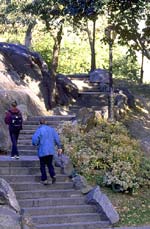 (Photo: Randall Shortridge) Quality, durability, and maintenance: These nearly 150 year old steps in New York's Central Park (designed by Olmstead and Vaux) are made of the same solid granite of the hill they scale; pavement, furnishings, landscape, and artwork must be maintained - and withstand constant use.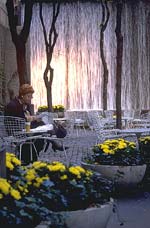 (Photo: Randall Shortridge) Sight and sound of water: The wall-sized fountain in Paley Park in Manhattan masks the sounds of the city; one quickly forgets the rush of the metropolis beyond.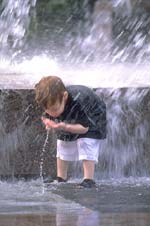 (Photo: Randall Shortridge) Interactive water: A young boy cannot resist the fountain in Waterfront Park in Charleston, South Carolina. Touching water, dipping our hands into it, submerging ourselves in its cool gentle embrace is - frankly - fun!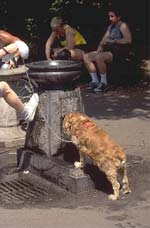 (Photo: Randall Shortridge) Pets (and their human companions): Dogs (and people) have a place to get water at this fountain along Central Park's East Drive. Both need places to run, socialize, get a drink of water and relieve themselves.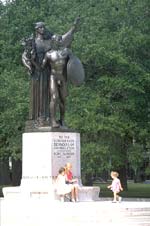 (Photo: Randall Shortridge) Artifacts and landmarks: Children visit a memorial to the defenders of Fort Sumter on the Battery waterfront in White Point Gardens, Charleston, South Carolina. Memorials and historic markers lend particular significance to a place, and are used as meeting places and directional indicators.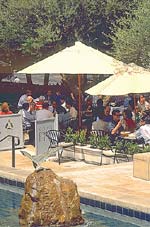 (Photo: Randall Shortridge) Dining areas: Outdoor seating for this restaurant shares the landscape and quiet atmosphere of the McGuire Gardens next to the Los Angeles Central Library. (Photo: Randall Shortridge) Vendors: Many street corners in downtown Portland, Oregon have flower carts like this one on Pioneer Square. Public space is enlivened and enriched by the likes of food, news, and sundries stands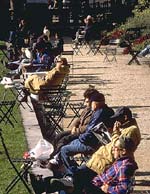 (Photo: Randall Shortridge) Seating: Movable chairs allow people to sit facing the sun throughout a cold fall day by visitors to Bryant Park in Manhattan. Movable seating allows groups to arrange themselves; flexible seating is by far the best kind for plazas and open lawns.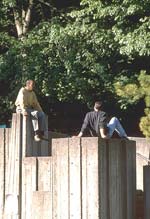 (Photo: Randall Shortridge) Dialogue: The Ira Keller fountain in Portland has a hundred places ideal for sitting down for a conversation; the huge waterfalls drown out sounds from the city on all sides. (Photo: Randall Shortridge) Play: Washington Square in Manhattan is home to nearly constant chess matches; expanses of hardy turf or paved plazas also allow organized or spontaneous play.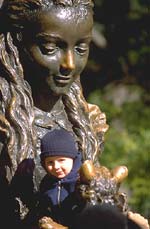 (Photo: Randall Shortridge) Children's play areas: One of the most popular places for small children in Central Park is the Alice in Wonderland statue; playgrounds with imaginative features help them develop their physical and social capabilities. (Photo: Randall Shortridge) Enclosure: The sloping grassy plane of Long Meadow in Brooklyn's Prospect Park creates a gentle enclosure; its flanks are topped with dense trees that completely hide the dense urban environment beyond, |
© 2002 ArchNewsNow.com